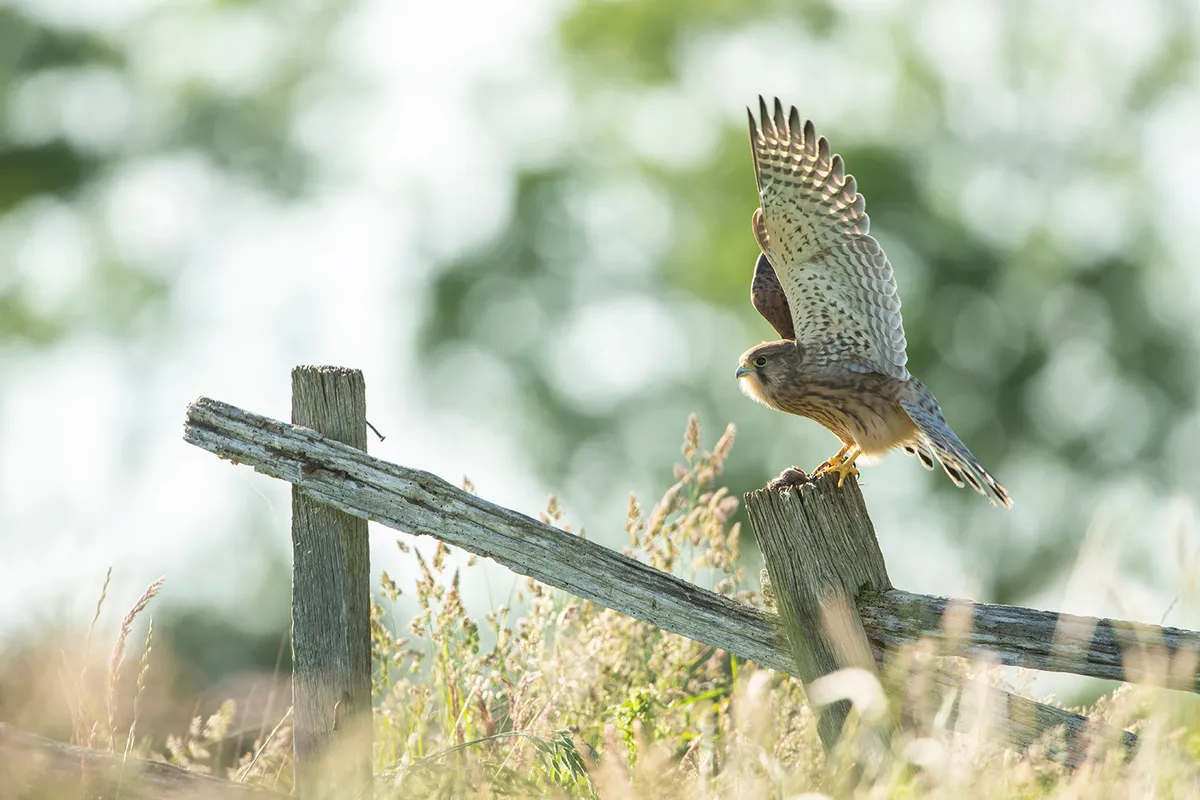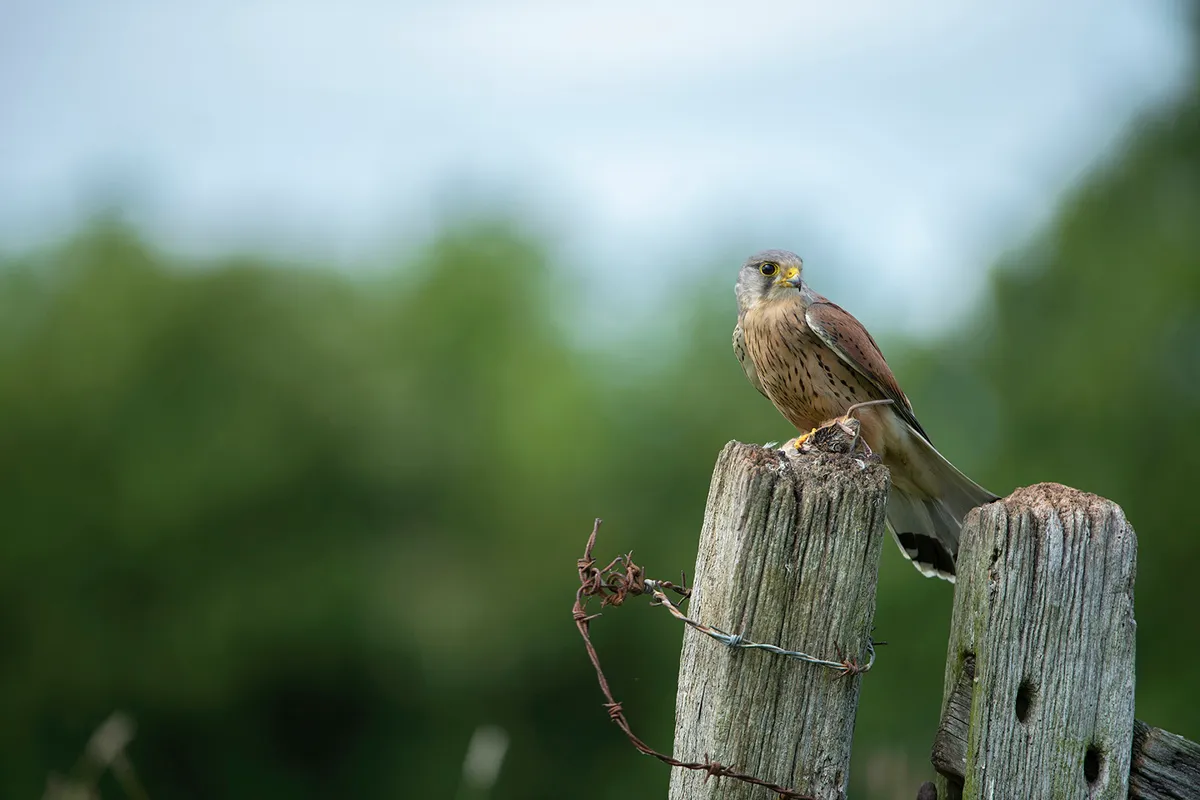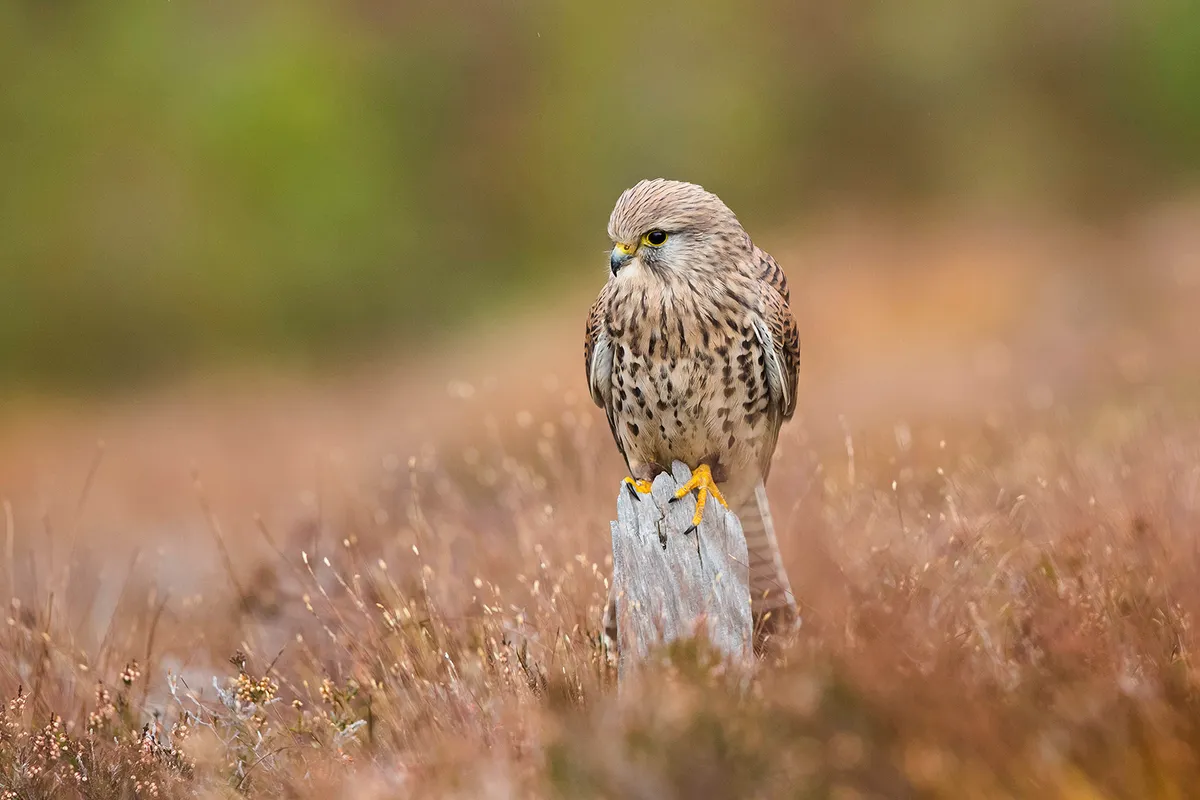The common kestrel is a relatively small bird of prey reaching 32-35cm in length with a wing span measuring up to 80cm. In the UK, it is usually just referred to as the kestrel, as it is the only kestrel species found here.
Kestrels are found in a wide variety of habitats, from moor and heath, to farmland and urban areas. The only places they do not favour are dense forests, vast treeless wetlands and mountains. They are a familiar sight, hovering beside a motorway or other main road. They can often be seen perched on a high tree branch, or on a telephone post or wire, on the look out for prey
Numbers of kestrels have declined in the UK since the 1970s, probably as a result of changes in farming and so it is included on the Amber List of Birds of Conservation Concern. They have adapted readily to man-made environments and can survive right in the centre of cities.
What is the scientific name of the kestrel?
The scientific name of the common kestrel is Falco tinnunculus. Other UK birds in the Falco genus are the merlin, the Eurasian hobby, and the peregrine falcon.
How to identify kestrels
The kestrel is a relatively small bird of prey, with a short neck and long, angular wings. Both the male and female have spotted reddish-brown backs, but the female is slightly larger and browner all over, with repeated black bands down its tail, while the male has a grey head and tail with a single black band at the end of its tail.
One way to help distinguish them from other small birds of prey, such as sparrowhawks, hobbies or merlins, is how it hunts. The kestrel hovers in the air while looking for prey, its tail fanned while it rides the air current or ferociously beats its wings to stay in place (this explains another one of its names, ‘wind-hover’).
How to identify kestrel pellets
Kestrel pellets are between 20-40mm long and 10-25mm diameter. They’re rounded at one end pointed at the other, and light grey in colour.
How to identify kestrel feathers

The tail feathers of the male are grey with that thick black band and the female brown with the same thick black band streaked through. The secondaries and primaries are quite striking, a black-brown with contrasting comb-like white bars with tinges of a rust red.
What do kestrels sound like?
Kestrels are usually silent, but they do sometimes give out a shrill kee-kee-kee, most often heard near the nest. This call is reflected in the second half of their Latin name - tinnunculus means ‘kestrel’ in Latin, from tinnulus meaning ‘shrill’ (a perhaps harsh indictment of their repetitive keening call).
There are a number of variations of this call – they will give a more spaced out kee-kee call when alarmed, and a quick fire shrill keekeekee while in flight. Mates will also give a shimmering call when greeting each other or passing food, a repeated vibrato each about a second long.
What do kestrels eat?

Kestrels mostly eat small mammals, particularly field voles. They’ll go through four to eight voles in a day, depending on the time of year, though they’ll also snap up shrews, mice, and occasionally larger prey such as moles and rabbits. In warmer weather they’ll even eat lizards! Kestrels that live on farms have learned to wait for tractors to flush out prey.
They’ll also go for birds including larks, pipits and starlings, or even the larger birds such as blackbirds. They’re more likely to do this in towns where there aren’t as many small mammals about. They’re not picky, however, and will regularly eat beetles, other insects and worms (they can see and catch a beetle from 50m away!).
How do kestrels hover?

Kestrel’s hovering is one of their most distinctive habits – they have an incredible ability to keep their head perfectly still while hovering in place. They do this by flying into oncoming wind at the same speed that it is coming at them – creating the illusion of a hover, while actually ‘flying forwards’.
To maintain position without dropping, they extend the tips of their wings and fans their tail feathers. They also have slightly stiffer feathers compared with other falcons, which stops them from bending too much.
What eats kestrels?
Adult kestrels aren’t in much danger from other predators, but their chicks can be vulnerable to predation from birds including corvids such as magpies and crows, or other birds of prey.
Where do kestrels nest?

Kestrels do not build a nest, preferring to scrape depressions for their eggs. They’re not too picky where – anywhere from cliff ledges or buildings, to holes in trees or old nests from other birds will do.
Please note that external videos may contain ads:
Cameras show kestrel nest built at quarry © BBC News NI
How many eggs do kestrels lay?
Kestrels usually have 4-5 eggs each year, laid in late April or early May. The female will lay them at two-day intervals with incubation taking about 27-29 days. Unusually for birds of prey, once the chicks hatch they display no aggression towards each other, and they’ll even fly, perch, and roost together after fledging.
Please note that external videos may contain ads:
Miranda's kestrel diaries © RSPB
When do kestrels leave the nest?
Kestrel young fledge after about four weeks and start to explore increasing distances from the nest. They still come back to the nest to roost, however, for another couple of weeks, and adults will continue to feed their young for about a month after they fledge until they are able to catch their own food.
More on birds of prey:
How long do kestrels live for?
The average age is four years old, but the oldest ever ringed by the British Trust for Ornithology was 15 years and 11 months.
Are kestrels endangered?

Kestrels are on the Amber List of conservation and are still on the decline. They were persecuted in the late 19th and early 20th centuries by gamekeepers, even though they pose very little threat to game bird chicks. There was less persecution through World War II, but then an influx of pesticides caused a serious decline in the late 1950s and 1960s.
They are still declining now, and though the main reasons are debated it is thought to be mainly down to farming practices, ie the continued use of pesticides and more intensive management of grassland which reduces small mammal populations.
What work is being done to help kestrels/ how can the public help?
One way you can help is by providing nestboxes. Kestrels don’t build their own nests, preferring to use cliff or building ledges, or reuse old nests from other birds such as the crow, so they’ll regularly take to nestboxes. You can make one yourself or purchase one from the RSBP shop – then just fix at least 15ft high in an isolated tree, pole, or building in an undisturbed location close to grassland and with good visibility.
